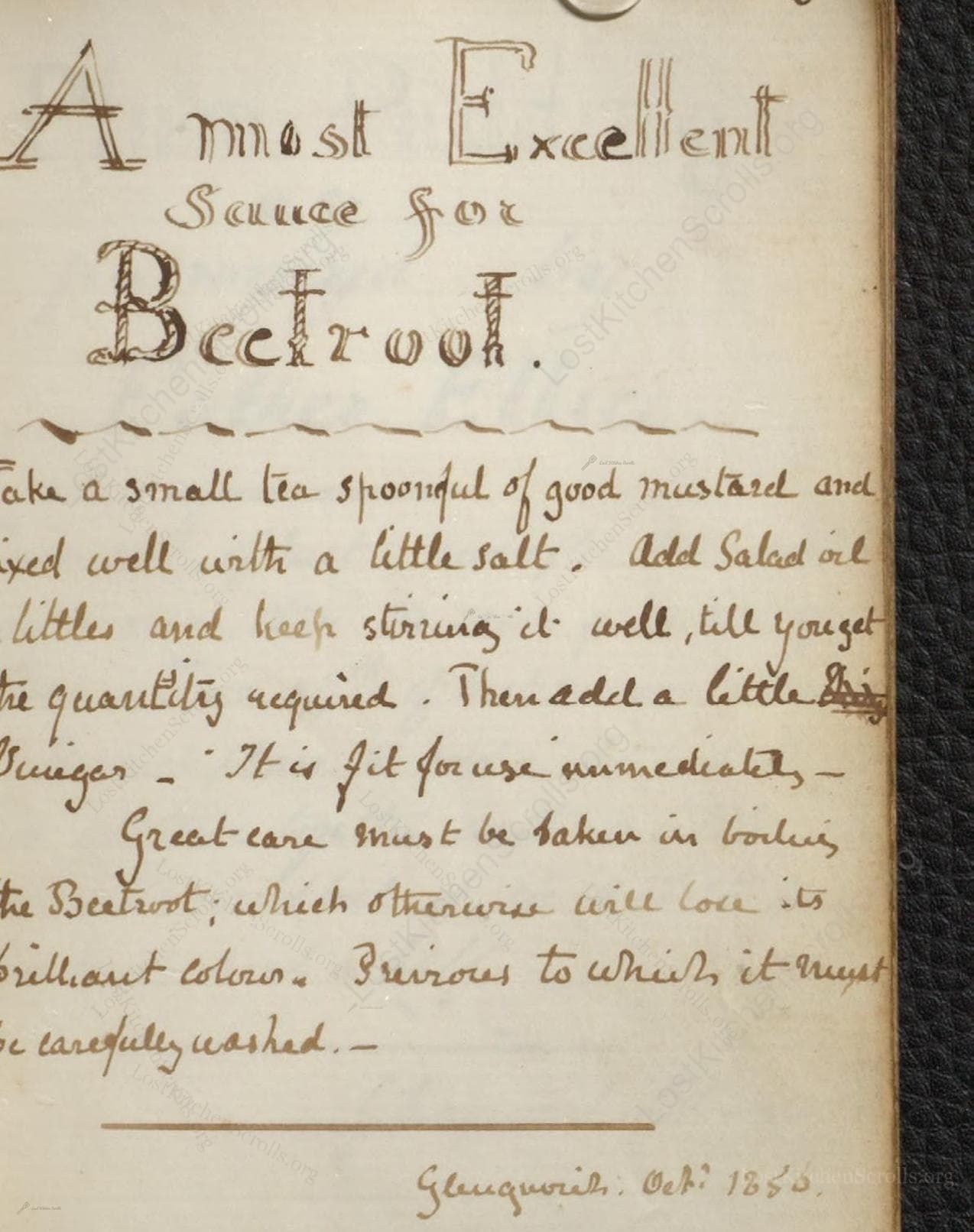
A Most Excellent Sauce For Beetroot
"Take a small tea spoonful of good mustard and mixed well with a little salt. Add Salad oil littles and keep stirring it well, till you get the quantity required. Then add a little Vinegar - It is fit for use immediately - Great care must be taken in boiling the Beetroot; which otherwise will lose its brilliant colour. Previous to which, it must be carefully washed. - Glenquorik. Octr. 1850."
Note on the Original Text
The recipe is written in a conversational and somewhat imprecise style, typical for manuscripts of the period, where measured quantities were often left to the cook’s discretion. Spelling like 'Octr.' for October and phrasing such as 'fit for use immediately' evoke the practical, immediate nature of recipe exchange among family and friends. Unusually, the caution about beetroot colour preservation shows a keen awareness of both aesthetics and technique—important in Victorian kitchens where visual appeal was gaining renewed emphasis. Terms like 'Salad oil' reflect the period before olive oil was widely common in Britain, and 'mixed well' simply means blended thoroughly by hand.

Title
Recipe book of Charles Ellice, Colonel, 24th Regiment (1856)
You can also click the book image above to peruse the original tome
Writer
Charles Ellice, Colonel
Era
1856
Publisher
Colonel Charles Ellice
Background
A charming manuscript cookbook chronicling the culinary escapades of Colonel Charles Ellice during his globe-trotting military career, featuring recipes from Highland butter to yeastless bread, spicy curries, and even a dash of Victorian medicine—all penned alongside evocative ink sketches and a personal index.
Kindly made available by
McGill University
This recipe is drawn from the mid-19th-century manuscript cookbook of Colonel Charles Ellice, a British officer who spent much of his career in India. Compiled over a quarter-century from 1856 to the 1880s, the book reflects both traditional British tastes and the increasing variety of foods encountered abroad. The beetroot sauce, noted as 'Excellent,' shows Victorian care in vegetable cookery and a cosmopolitan approach to seasoning, blending British mustard with the continental practice of oil-and-vinegar dressings. Glen Quoich, the location attributed, was a Highland estate, connecting the recipe both to traditional British kitchen garden produce and to the growing influence of European and colonial cuisines in the officer class.

A small mixing bowl and teaspoon were essential, along with a whisk or fork for blending the dressing. For boiling the beetroot, a medium saucepan or pot would have been used, and the beetroot washed in a basin or under a kitchen pump. A sharp knife was required for slicing the beetroot once cooked. The entire preparation would have relied on strong arm whisking and careful attention to prevent overcooking and colour loss.
Prep Time
15 mins
Cook Time
50 mins
Servings
2
We've done our best to adapt this historical recipe for modern kitchens, but some details may still need refinement. We warmly welcome feedback from fellow cooks and culinary historians — your insights support the entire community!
Ingredients
- 1 medium beetroot (about 7–9oz), washed but unpeeled
- 1 teaspoon (0.18oz) English mustard powder or prepared mustard
- 1 pinch salt (0.04oz)
- 2–3 tablespoons (1–1.5fl oz) salad oil (such as sunflower or light olive oil)
- 1–2 teaspoons (0.17–0.34fl oz) white wine vinegar or cider vinegar
Instructions
- Begin by placing 1 teaspoon (about 0.18oz) of good quality English mustard into a small bowl and add a pinch of salt (about 0.04oz).
- Gradually whisk in 2–3 tablespoons (1–1.5fl oz) of mild salad oil, such as sunflower or light olive oil, slowly dribbling it in while continuously whisking, until you reach the quantity and texture you desire—think of it as making a quick mustard vinaigrette.
- Finish by stirring in 1–2 teaspoons (0.17–0.34fl oz) of white wine or cider vinegar.
- The sauce is ready to use immediately.
- For the beetroot, select fresh, unblemished roots.
- Gently wash them, taking care not to break the skin or stems, as this helps retain the vibrant colour during boiling.
- Place them in a pot of simmering water (whole and unpeeled), and cook until tender.
- Once done, let them cool slightly before slipping off the skins.
- Slice and serve with the sauce drizzled over.
Estimated Calories
165 per serving
Cooking Estimates
It takes about 40–60 minutes to cook the beetroot until tender. Preparing the mustard vinaigrette and slicing the beetroot will take about 10–15 minutes more. Each serving has about 165 calories, and this recipe serves one person as a main small salad or two as a side.
As noted above, we have made our best effort to translate and adapt this historical recipe for modern kitchens, taking into account ingredients nowadays, cooking techniques, measurements, and so on. However, historical recipes often contain assumptions that require interpretation.
We'd love for anyone to help improve these adaptations. Community contributions are highly welcome. If you have suggestions, corrections, or cooking tips based on your experience with this recipe, please share them below.
Join the Discussion
Rate This Recipe
Dietary Preference
Main Ingredients
Culinary Technique
Occasions

Den Bockfisch In Einer Fleisch Suppen Zu Kochen
This recipe hails from a German manuscript cookbook compiled in 1696, a time whe...

Die Grieß Nudlen Zumachen
This recipe comes from a rather mysterious manuscript cookbook, penned anonymous...

Ein Boudain
This recipe comes from an anonymous German-language manuscript cookbook from 169...

Ein Gesaltzen Citroni
This recipe, dating from 1696, comes from an extensive anonymous German cookbook...
Browse our complete collection of time-honored recipes



